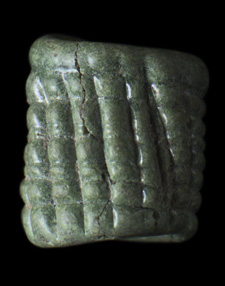 STUDIO PHOTOGRAPHS
STUDIO PHOTOGRAPHSIntroduction | Research | People | Tools
 STUDIO PHOTOGRAPHS
STUDIO PHOTOGRAPHS
GLASS BEAD (TYA 642: 2839)
Type: Greenish bead, covered by check consisting of vertical and horizontal grooves.
Use: Jewel.
Site: Raisio, Ihala, Mulli abode.
Period: Viking Age / Crusade Age / Early Middle Ages
Dating: 980-1220 A.D.
Weight: 2 g.
Photographer: Antti Huittinen.
The first glass beads were manufactured in Syria in ca. 5000 B.C. but in Finland glass beads were taken into necklaces not until in the 4th century A.D. Glass is made of quartz sand and alkali (e.g. sodium carbonate or potash made of wood ashes). Glass beads have been manufactured of cold or heated glass. Pieces cut of cold melted glass can be polished like semiprecious stones. Beads made of molten glass can be made by twisting the heated glass on a metal skewer.
In Finland there is no evidence of manufacturing glass beads. Probably glass was not able to be made in Scandinavia but proofs of making glass beads are known in some Viking-Age cities in Scandinavia. In ancient Russian cities, glass-making became common when the Middle Ages came nearer. For example, manufacture of beads in known in Staraya Ladoga, on the south shore of Lake Ladoga, from the 8th century to the early 11th century.
Other pictures:
Other related topics:
Introduction | Research | People | Tools